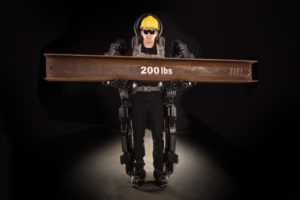Sarcos’ Brad Kell on AR in Robotics
New AREA member Sarcos Robotics is an industry leader in dexterous robotic systems with a long history of innovation. The latest example currently in development is the Guardian™ XO®, a full bodied, powered, untethered, industrial exoskeleton suit that improves human strength and endurance without restricting the operator’s freedom of movement. We spoke recently with Brad Kell, Senior Engineer and Program Manager of Sarcos, about his company and its plans for implementing AR.

AREA: Sarcos has been a pioneer in robotics for 25 years now, most recently with its Guardian XO exoskeleton. How does AR fit into the picture?
KELL: While Sarcos has been building robots a long time, the Guardian XO under development will be our first exoskeleton product with an intelligent user interface. We need to understand how people are going to interact with the XO, for example, how information is presented to the user, how that information is used, and how to make things easier for the user so they can focus on the task at hand. We see AR fulfilling many of these requirements and being an important part of the product.
AREA: What kinds of user requirements are you expecting to see in the future?
KELL: We see a number of possibilities as more exoskeletons and similar systems come into use, particularly regarding access, presentation, and use of information, hands-free operation, and awareness of and interaction with the surrounding environment – for example, things like hazard avoidance and semi-automated user guidance.
AREA: It sounds as if somebody at Sarcos was looking at what the capabilities of the exoskeleton would be, how complex the future of this product would be, and decided that traditional forms of user interface were not going to be sufficient.
KELL: We could make an exoskeleton that is functional today using a traditional interface, but we are looking towards the future along with our customers. They are looking for a good user experience and better ways to control new technology that also integrates with AR systems they are already evaluating for other applications. Given the nature of our product, hands free operation is particularly important and is a critical driver to make sure we are meeting our customer’s needs.
AREA: Is AR being considered exclusively for the exoskeleton or will it be used in other Sarcos products?
KELL: When we talk about long-term strategy, we recognize that it is very important. We’ve already discussed wider use of AR internally and with our customers and we’ve started to evaluate select existing technologies as a first step. We have several products that could really benefit from AR technologies. With our Guardian S product we expect to enable enhanced inspections through the use of AR.
AREA: What aspects of AR are you exploring right now?
KELL: A user in an exoskeleton is not necessarily going to have hands available to push buttons. They want to tell the system what to do, and the system should give them audio and visual feedback. They may want to visualize digital three-dimensional models and documentation. We can see the potential AR can bring to our integrated strategy. It’s a matter of us selecting an appropriate technology and seeing how it fits into our product delivery schedule.
AREA: Can you give us a sense of the next near-term milestone in the Sarcos AR strategy?
KELL: Our targeted commercial design release for the delivery of the XO is late 2019. Until then, we must work through technology selection, and make sure it is compatible with what our customers want and expect or will allow. Once we decide what to do, select AR technology could be integrated with our existing systems and tested to make sure that it meets specifications.
AREA: What do you hope to gain through your membership in the AREA?
KELL: We’ve already been exposed to some new technologies and met some other AREA members. Our goals are to get a better understanding of what’s out there, meet potential partners, and have an opportunity to evaluate ideas and technologies to see how they might address our customers’ needs. The other thing that’s very interesting is access to early adopters. There’s nothing better than working with people to get insight on something they have already tried.